Hiking can be intimidating for beginners. We’ve made the mistakes so you don’t have to – learn how to choose a hike, select gear, stay safe outdoors and other essentials.
One of the reasons I created Trailcations is because in the past I struggled to find resources to take absolute beginners like myself who didn’t know a whole lot about the outdoors and help them learn how to be safe and have fun in nature.
Now with over 10,000 trail miles under foot from hiking, biking and paddling around the globe, I’m here to help you learn how to have the best day hiking trips possible! So lace up those boots and let’s get to learning the basics of Day Hiking 101.
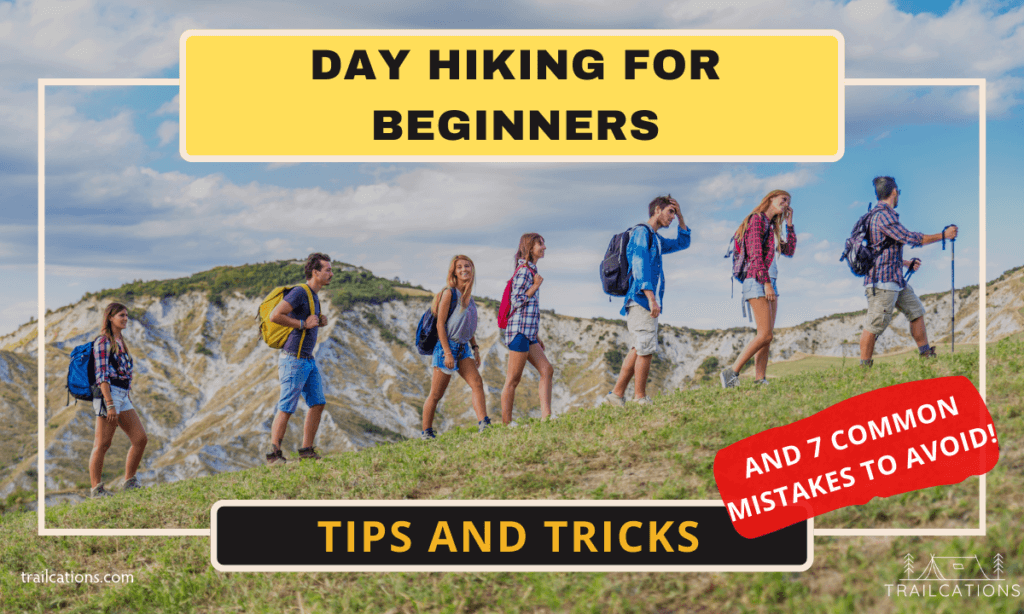
Table of Contents
- What is Day Hiking?
- How Long is a Day Hike?
- What to Consider When Planning a Hike for Beginners
- How Do Beginners Prepare for Hiking?
- The 10 Essentials: What to Pack For Day Hiking
- Other Gear Essentials for Beginner Day Hikers
- How Do I Plan a Day Hike? 3 Boxes to Check for Beginner Day Hikers
- Safety and Preparedness
- Trail Etiquette for Beginner Day Hikers (and a Friendly Reminder for Experienced Hikers)
- Benefits of Day Hiking for Health and Wellness
- Fitness and Training for Day Hiking for Beginners
- Nutrition and Hydration for Beginner Day Hiking
- Environmental Impact
- What Are Common Mistakes Beginners Make When Hiking?
- What Not to Do on Your First Day Hike: My Real Life Brush with Death
- Frequently Asked Questions
What is Day Hiking?
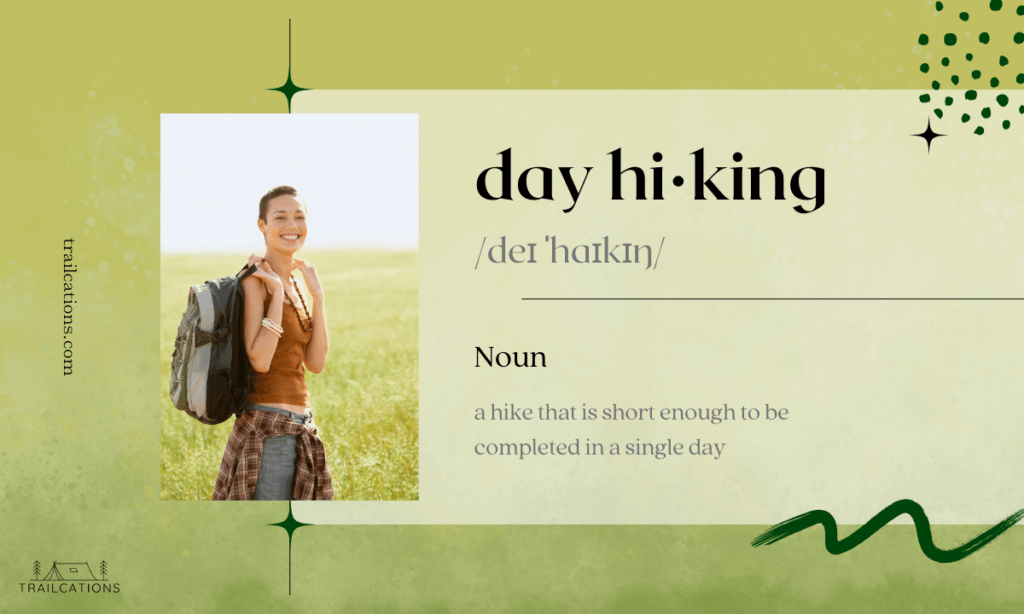
Hiking is defined by the Oxford Languages Dictionary as “the activity of going for long walks, especially in the country or woods.”
Day hiking is a type of hiking that is short enough to be done in a single day, as opposed to an overnight or multi-day excursion like a backpacking trip or a thru-hike. Day hikes are essentially walking trips on an established, maintained trail that are completed in a day.
Pro Tip: Day hikes are a great way to explore the outdoors and enjoy nature without having to commit to a long and arduous journey or having to sleep outside in a tent, hammock or tarp.
Day hiking is an excellent way to get some exercise and fresh air, and it can be done by people of all ages and fitness levels. Keep in mind that if you’re going hiking in a group, your group can only go as fast as the slowest person (or pet!).
The beauty of day hiking is that it can be as simple or as challenging as you want it to be. It can range from a leisurely stroll around your local park to a strenuous trek up a mountain. The length and difficulty of the hike depend on your personal preferences and fitness level.
Pro Tip: It’s easy for beginner (and even advanced) day hikers to overestimate their abilities. Make sure to choose a hike that is appropriate for your or your group’s level of fitness and experience.
Is Hiking Basically Walking? What’s the Difference Between Hiking and Walking?
When exactly does a walk turn into a hike? We aren’t in the position to be gatekeepers here as the terms hiking and walking are often used interchangeably. This hotly contested subject in the outdoor community generally distinguishes between walking and hiking in terms of trail surface, proximity to civilization, equipment needed and trail length.
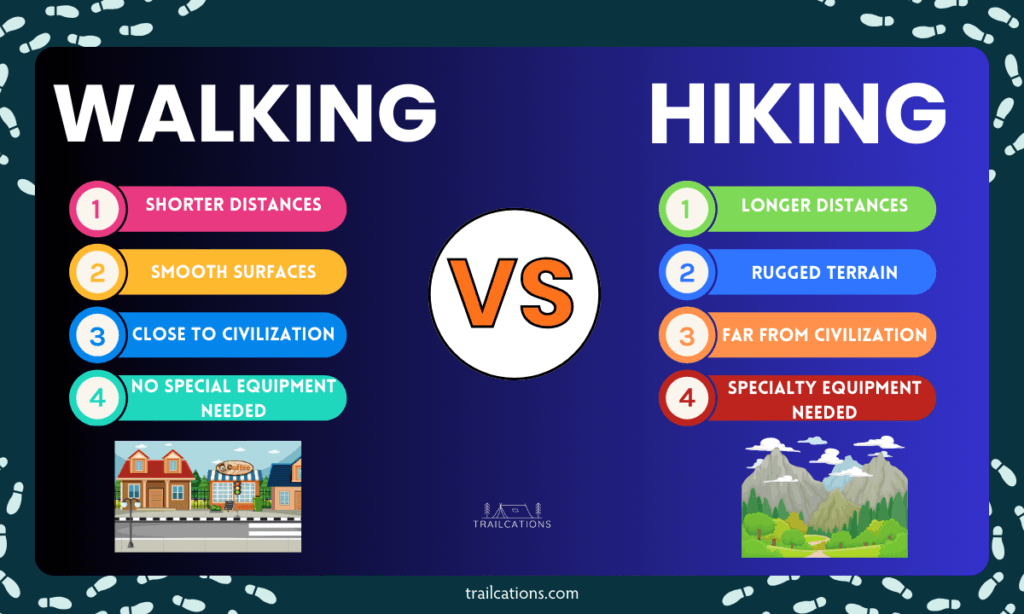
Walking
Walking trips are usually shorter distances, taking place on smoother surfaces, closer to civilization. There’s no specialty equipment needed. Walks are accessible to pretty much anyone as the smooth paths are perfect for baby carriages, wheelchairs and other assistive mobility devices.
Hiking
Hiking is basically walking longer distances on more rugged trails. Since hiking typically occurs further from civilization, it means this activity requires more specialty equipment than walking (ex: first aid kit, water, navigation tools, etc.). However, hiking can be extremely rewarding in terms of scenery, beauty, exercise and enjoying nature.
There’s No Hard and Fast Definition of Hiking vs. Walking
There’s no specific length of path or type of terrain that distinguishes a hike from a walk. Sometimes I even refer to my thru-hike of the Appalachian Trail (a 2,200 mile / 3540 km long trail through 14 states in the USA) as “that time I walked for six months straight.” Heck, even comedic author Bill Bryson’s iconic Appalachian Trail hiking book is ironically titled A Walk in the Woods!
How Long is a Day Hike?
A day hike is however short or far you want it to be. There are lots of amazing day hikes across the globe that are under 5 miles (8 km). However, make sure to check trail length, elevation gain and determine the pace of the slowest member of your group to understand if a day hike is right for you.
The average hiker can hike about 2 miles an hour (3.2 kph), meaning most hikers will plan for 3-12 miles (5 to 20 km) for a day hike. However, factors like elevation gain, your experience level, your fitness level and amount of sunlight that you have can all influence day hike length.
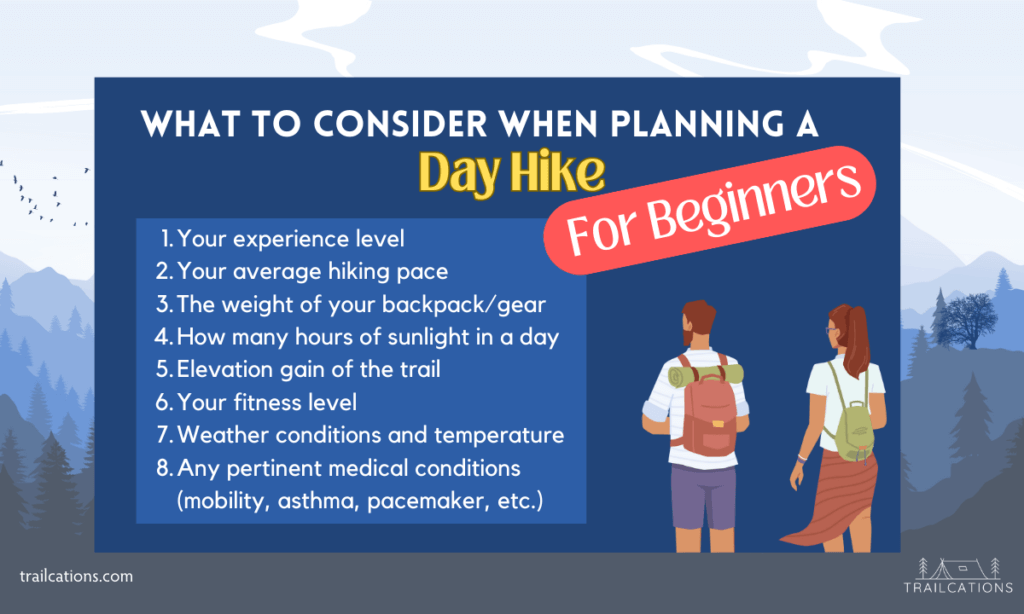
What to Consider When Planning a Hike for Beginners
Some factors to consider while planning a day hike should be:
- Your experience level
- Your average hiking pace
- The weight of your backpack/gear
- How many hours of sunlight in a day
- Elevation gain of the trail
- Your fitness level
- Weather conditions and temperature
- Any pertinent medical conditions (mobility, asthma, pacemaker, etc.)
When planning a solo hike, look at all of these factors in regards to yourself. If you’re hiking with a group, make sure to plan your hike in regards to the slowest member of the group.
Plan Your Day Hike with the Slowest Member of Your Group in Mind – Don’t Make My Mistakes!
When you don’t plan your hike with the slowest member of your group in mind, it can lead to frustration, injury or someone getting left behind with no resources.
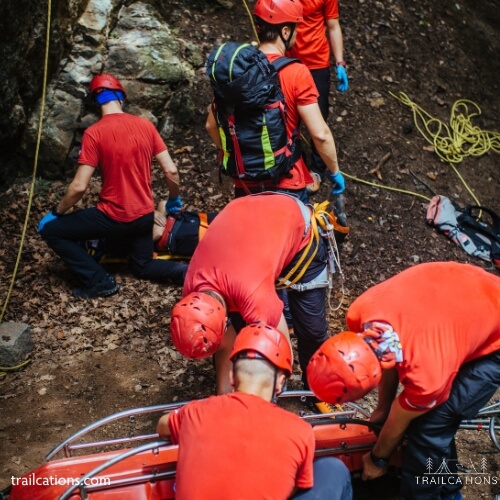
When I was learning how to lead a group hike from someone who was also inexperienced (but had convinced others they were experienced enough to lead a backcountry trip), we ended up evacuating a hiker from the backcountry because we didn’t plan our hike with the slowest member of the group in mind.
There were a series of mishaps that day but the main one was that we failed to collect pertinent medical info beforehand and we hiked too fast for the slowest member in our group. We ended up hiking too quickly of a pace and this hiker struggled before starting to go into shock. Little did we know that he had a heart condition and his pacemaker started working too hard.
After having the hiker rest, giving him electrolytes and fluids to drink and elevating his legs, he still was deteriorating. I slapped my FitBit on his wrist to take vital signs because I was having trouble counting his pulse manually.
Normal pulse rate is 50-100 BPM (beats per minute). His pulse was jumping wildly from 30 BPM to 150 BPM and back down again. I asked him if this was normal and he finally disclosed that he had a pacemaker because of an erratic heartbeat.
We immediately called 911 because you don’t mess around with heart conditions in the backcountry. I had my Personal Locator Beacon (PLB) on in case cell service didn’t work but we were on a ridge with a couple bars. Luckily it all ended up okay with the hiker being checked out by EMTs and then driven back to his car by the ambulance (he refused to go to the ER) but it was a scary situation for a while and could’ve been a lot worse.
Pro Tip: Remember to always plan your day hike with the slowest member of your group in mind.
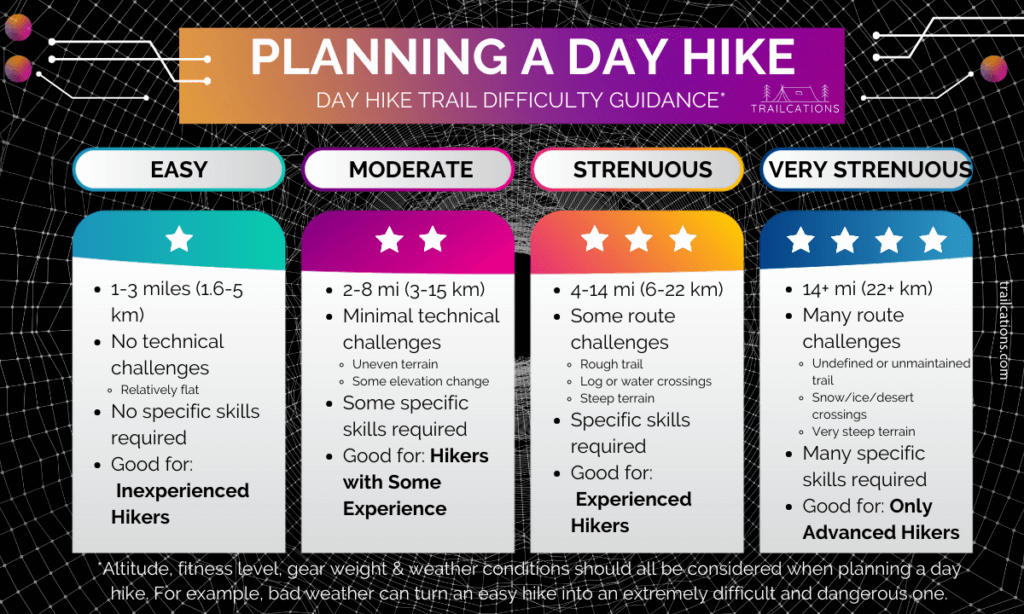
Examples of Day Hiking Length Based on Experience Level
There are no hard and fast rules for day hike length as there are so many factors to consider regarding the environment and your own abilities. However, if you’re just starting out trying to learn about hiking for beginners, you generally want to keep mileage (kilometrage?) low so you can actually enjoy yourself.
Based on hiking experience level, here are some general rules of thumb of hike length to aim for.
- Inexperienced Hiker: 1-3 miles (1.6-5 km)
- Some Experience: 2-8 miles (3-15 km)
- Experienced: 4-14 miles (6-22 km)
- Advanced: 14+ miles (22+ km)
The more experience you have, the better you’ll understand your strengths (ex: you love hiking in cold weather so you hike faster) and weaknesses (ex: you hate the uphills so you hike slower). You’ll be able to dial in your gear more and understand when you need to take a snack or rest break.
Pro Tip: Most importantly when day hiking, listen to your body! The trail will always be there, but you might not be if you push yourself too hard. Remember, you can always turn around if conditions are bad, you’re running low on food or water or the trail is way harder than anticipated.
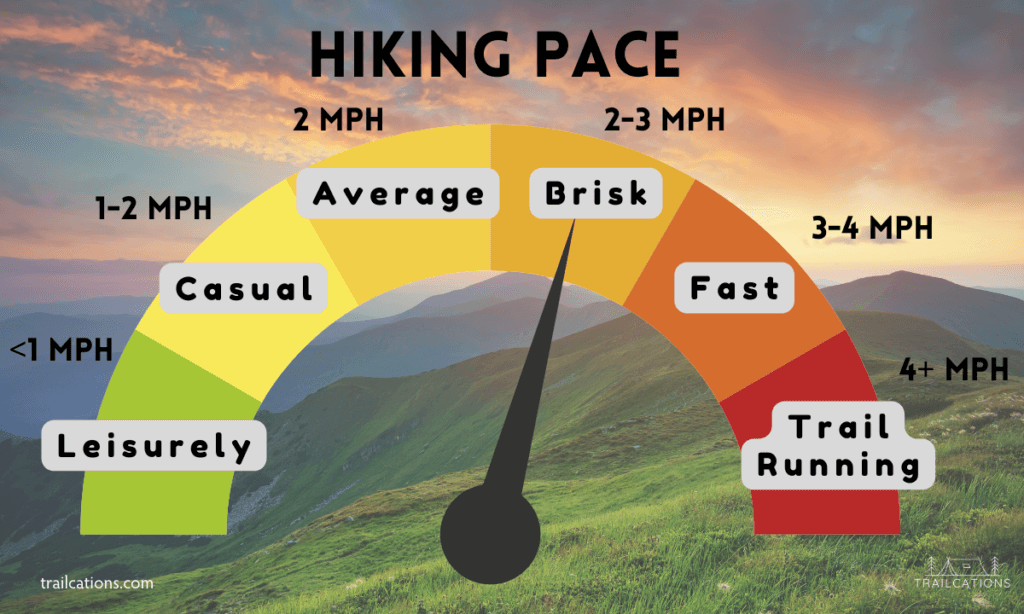
How Do Beginners Prepare for Hiking?
To prepare for a day hike for beginners, it’s important to plan where you’re going, check the weather and pack the right gear and supplies.
Some of the basic essential items to bring on a day hike include a backpack, water, food, appropriate footwear and clothing. It is also a good idea to bring a map and a compass (and know how to use them!) in addition to a GPS device or app to help navigate the trail.
Pro Tip: Always, always, ALWAYS tell someone where you’re going, even if you’ve been on that trail dozens of times. Doesn’t matter if it’s 1 mile or 100 miles, if you’re a beginner hiker or an expert. The movie 127 Hours is an infamous example of when things quickly go wrong in the backcountry when you don’t tell anyone where you’re going or when you’ll be back.
With a little preparation and planning, day hiking can be a fun and accessible way to explore the outdoors and get some exercise. With the right gear and some basic skills, anyone can enjoy a day hike, regardless of their experience level.
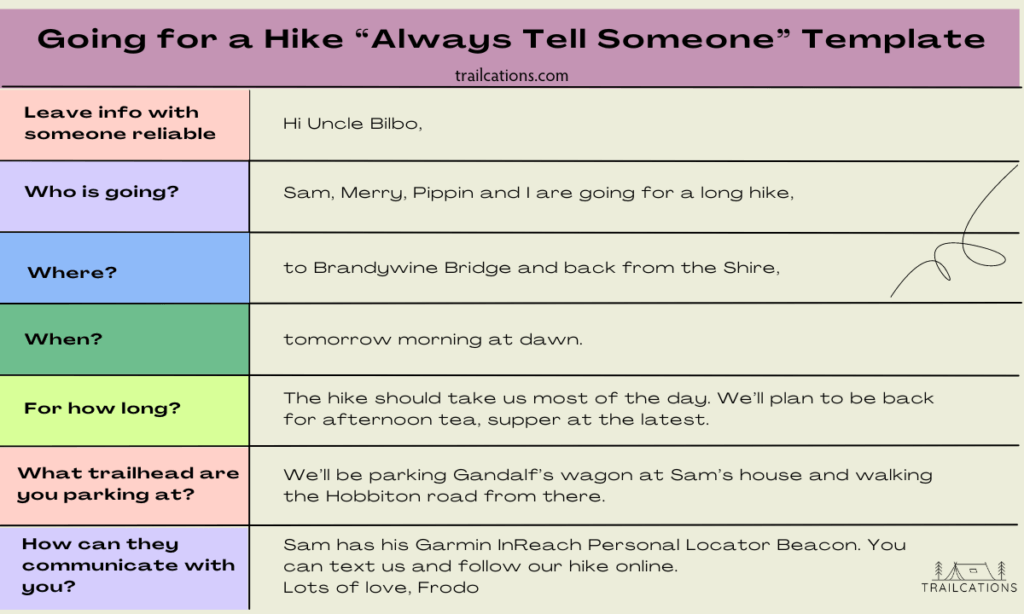
To prepare for hiking, beginners should consider the following key aspects:
1. Pick Your Trail
Choose a trail that matches your fitness level and hiking experience. Consider the trail’s difficulty, length and terrain.
If you’re going with a group, keep in mind that you can only go as fast and as far as the slowest member. Also check beforehand to see if you need permits, what the parking situation is like, any seasonal closures, weather conditions and if there is an entry fee.
Pro Tip: Check out hiking trail websites and apps to find local day hikes near you. Crowdsourced trail inspiration and information apps like AllTrails, Komoot and Hiking Project can help you understand the difficulty of a trail, recent trail conditions and about how long a hike will take.
2. Get in Shape
Physical training is important to prevent injuries while day hiking. Start with regular walks or runs and gradually increase the intensity and duration. Incorporate resistance training to strengthen your legs, glutes, and core muscles.
If you’re not in the best shape (or really enjoyed eating ice cream while bingewatching Netflix as your main form of training like I did before a 6 month thru-hike), don’t worry! Just tone down the length and intensity of trail you’ll be doing and don’t forget to pack some extra blister bandaids and anti-chafe cream.
3. Pack Your Hiking Essentials
Pack the necessary gear, including a suitable backpack, clothing layers, proper footwear, navigation tools, first aid kit and sufficient water and food. Sometimes hikes can last longer than anticipated or an unexpected injury may mean you’re out on the trail after dark so don’t forget a headlamp, fire starter and emergency shelter like a space blanket.
Depending on the season and location, you may find yourself needing to carry extra gear like snowshoes, bug spray, blaze orange clothing during hunting season or bear spray.
Pro Tip: Always remember to bring personal medications on a hike, especially if someone in your group has an allergy. EpiPens and antihistamines save lives!
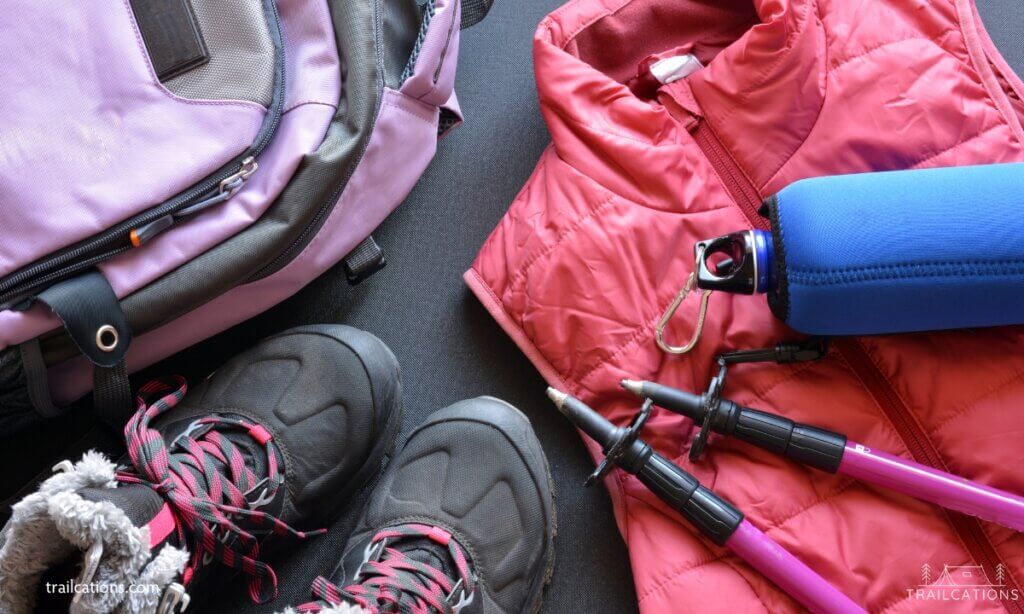
4. Use the Layer Approach for Clothing
Dress in layers to manage body temperature and moisture. Avoid cotton and opt for moisture-wicking fabrics like polyester, nylon, wool, alpaca or bamboo. Bring a hat, sunscreen and sunglasses for sun protection and tall socks or pants for tick, mosquito and bug protection.
Pro Tip: Experienced outdoor enthusiasts have likely heard the saying, “Cotton kills,” referring to the poor wicking and insulating properties of cotton once it gets wet or sweaty. As cheap as it is, avoid cotton or cotton blends in hiking clothes and instead choose nylon, polyester, bamboo, wool or other wicking fabrics. You’ll be a lot warmer and happier!
5. Warm Up and Cool Down
Always warm up before hiking to prevent injuries and cool down and stretch after the hike to aid recovery. Especially if you have a sedentary job or don’t regularly exercise, warm up with stretching and take it easy so you don’t get injured! Avoid becoming part of the “Weekend Warriors” who push their bodies too hard and end up in crutches at the office come Monday morning.
6. Start Slowly and Gradually Increase Intensity
Begin with shorter, easier hikes and progressively challenge yourself with longer and more difficult trails. Hiking is about having fun and enjoying being outside, not sucking wind and hating everything because you did too much too soon! If you’re not having fun hiking, it’s just another leg day. Womp womp.
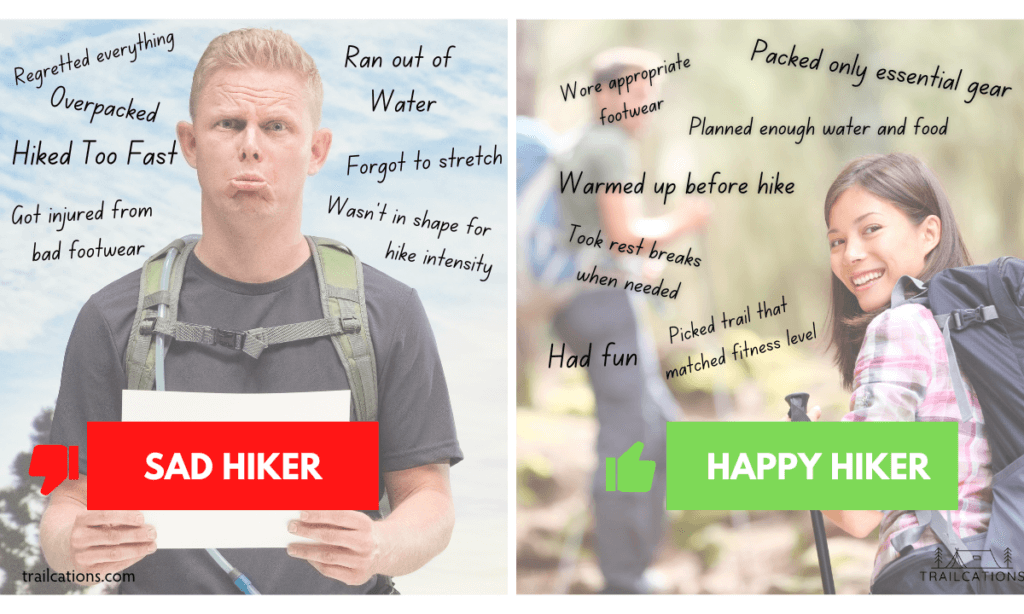
7. Seek Advice and Join Hiking Groups
Consult experienced hikers for trail recommendations and join hiking groups to learn from others and enhance safety. Plus it’s a great way to meet new friends! There are lots of free outdoor meetup groups, hiking apps, online forums and Facebook groups where you can ask for advice or find ideas for your next day hiking trip.
So, How Far Can a Beginner Hike in a Day?
Absolute beginners with no experience should stick to shorter distances of 1-3 miles (1.6-5 km) and easier trails for day hiking. In general, beginners should focus on trail selection, physical preparation, proper gear, clothing, and warm-up/cool-down routines. Starting slowly, seeking advice and gaining experience, and gradually increasing the hiking intensity are also important for a successful hiking experience.
The 10 Essentials: What to Pack For Day Hiking
Day hiking is a great way to enjoy the outdoors, get some exercise and explore new trails. However, it is important to be prepared for your hike to ensure a safe and enjoyable experience.
Even if you’ll be gone only for an hour or two, there’s a few items that every hiker should bring with them in a small backpack or bag. In hiker lingo, these items are often referred to as “The 10 Essentials.”
The 10 Essentials are the basic items you should have with you on any outdoor trip for first aid or in an emergency. This can include minor injuries, abrupt weather changes or unexpected delays.
Keep in mind that these essentials are only the basic items you should bring with you. You ‘ll likely need additional gear depending on the season, type of outdoor activity and location (ex: micro spikes, life jacket, bear spray). Always visit your park or region’s website to learn more about the area before heading out.
Pro Tip: Even if you have all the right gear, things can still go wrong in the backcountry if you don’t know how to use the item. Many hikers assume that because they bought the latest and greatest gear that they’ll be safe. However, if you don’t know basic wilderness survival skills like how to start a fire or what the signs of hypothermia are, you can quickly find yourself in trouble on a hike.
Here are the 10 Essential Items to bring on your day hike:
- Navigation: Map, compass, GPS device, personal locator beacon, backup power bank.
- Illumination: Headlamp, flashlight or lantern.
- Sun protection: Sunglasses, sunscreen, hat, sun shirt, sun pants.
- First-aid supplies: First-aid kit, personal medication.
- Gear Repair: Duct tape, knife or multi-tool, super glue.
- Fire: Matches, lighter, firestarter.
- Shelter: Emergency bivy or space blanket, signaling whistle and mirror.
- Extra clothing: Sufficient layers to survive worst-case scenario weather.
- Food: High energy snacks and meals, about 200-300 calories per hour of hiking.
- Water: At least 1 Liter per 2 hours hiking, water purification method.
These items are part of the 10 Essentials and can be tailored to your trip based on considerations such as weather, difficulty, duration and distance from help. Always consider the length, weather and difficulty of your hike when deciding what to pack for day hiking.
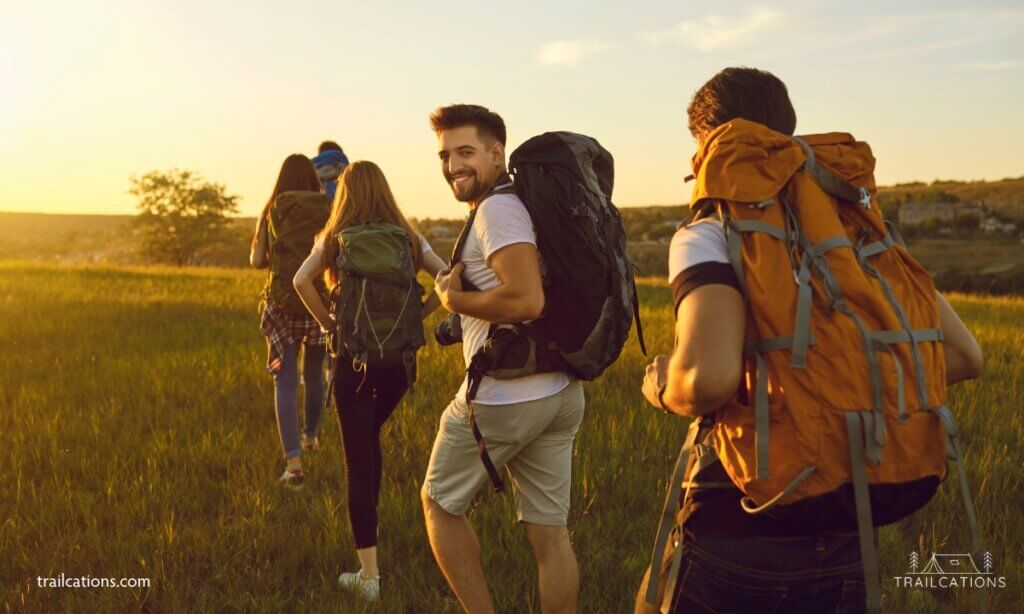
Other Gear Essentials for Beginner Day Hikers
Other essential items to bring on your day hike include a backpack to carry all of your essentials, bathroom hygiene items and any seasonal or regional-specific items.
Backpacks for Day Hiking
Backpacks, bags, hydration packs or fanny packs (waist or bum bags) are important to keep all your gear stowed away while you’re hiking. You want the bag to be comfortable while trekking for a few hours but also allow you to be hands-free in rough terrain.
Best types of bags for day hiking
- 20-30 Liter backpack
- Sling bag
- Hydration vest or hydration pack
- Fanny pack or bum bag
- Waterproof pack cover or DIY contractor trash bag liner for your pack
How Big of a Backpack do I Need for Day Hiking?
For day hiking, the size of the backpack you need can vary based on the duration of your hike and the amount of gear you plan to carry. Here are some general guidelines:
- A smaller-sized 15-25 liter backpack is usually sufficient for half-day hikes.
- For all-day hikes or winter hikes, a larger pack in the 25-35 liter range is recommended to carry extra water, food, clothing, and the 10 essentials.
- If you’re a winter day hiker and snowshoer, a 35-40 liter backpack may be necessary to accommodate bulkier insulated clothing and additional gear such as snowshoes and microspikes.
- It’s important to consider the gear you plan to carry, such as food, water, extra clothing, and the 10 essentials, when choosing the size of your backpack.
Ultimately, the size of the backpack you need for day hiking depends on your specific gear requirements and the duration and conditions of your hike.
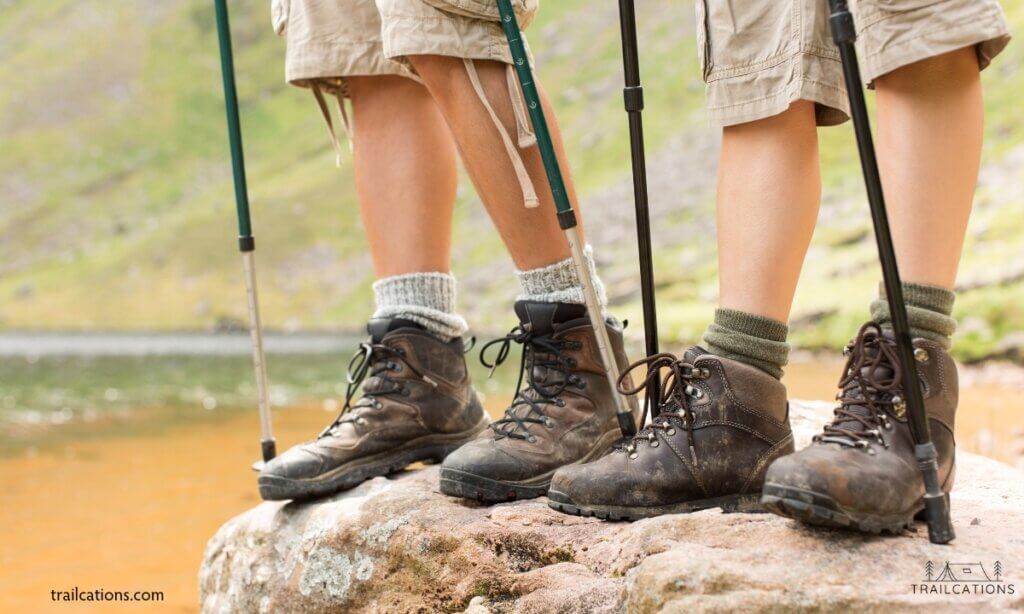
Bathroom Hygiene Items for Day Hiking
When nature calls on the trail, you don’t want to be left without the necessary hygiene tools. Make sure you pack some toilet paper, hand soap, a small trowel and trash bag so you’re not sweating it.
Backcountry Bathroom Items for Day Hiking
- Toilet paper (no need for a whole roll – just roll up a length of it)
- Plastic ziploc bag for used toilet paper, pads, tampon trash
- Small container of Castile soap or hand sanitizer
- Lightweight trowel for digging 6-8″ deep cat hole for #2
Pro Tip: For discreet bathroom trash disposal in the backcountry, place a ziploc style bag inside an opaque plastic grocery bag. The ziploc bag keeps the toilet paper smells in and the plastic grocery bag offers visual discretion. Even though everyone goes to the bathroom, no one wants to be hiking behind you staring at and smelling your dirty toilet paper!
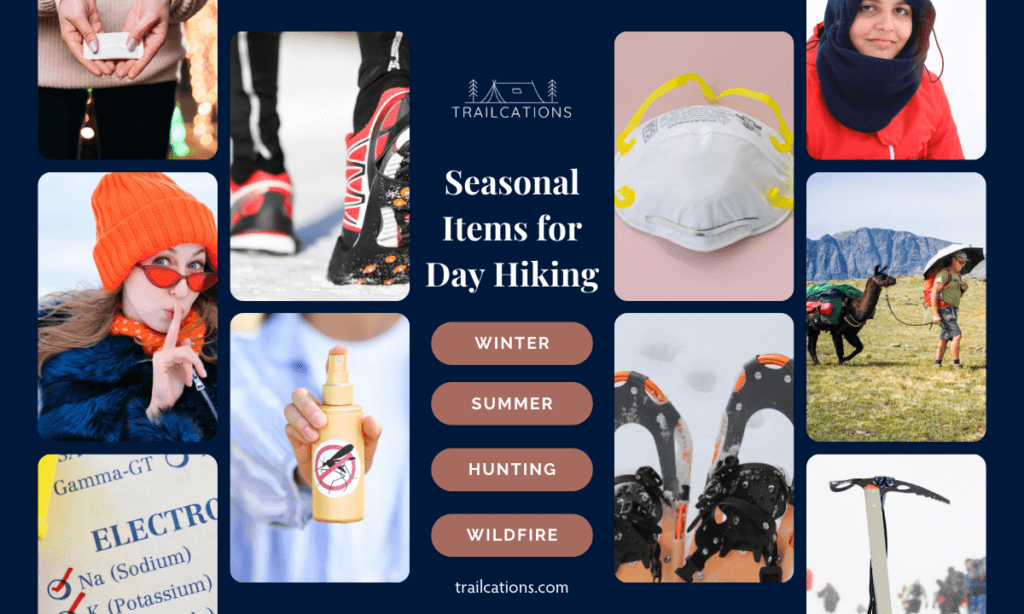
Seasonal Items for Day Hiking
Seasonal items could include an extra jacket, bright orange clothing for hunting season, bug spray or snowshoes. Depending on weather conditions, you may also have to bring some of these seasonal items with you while hiking in spring or fall.
Hot Weather Seasonal Items for Day Hiking
- Bug spray
- Insect net for head
- Extra electrolytes to replenish sweating
- Sun umbrella
- Sun gloves
Cold Weather Seasonal Items for Day Hiking
- Extra layers or jacket
- Fleece pullover
- Warm neck gaiter or scarf
- Snowshoes
- Micro-spikes
- Ice axe (depending how steep and snowy the terrain is)
- Waterproof gaiters or snow pants
- Hand or foot warmers
Hunting Season Items for Hiking
- Bright orange hat
- Bright orange vest, jacket, shirt (may have to be a minimum size – check local regulations)
Wildfire Season Items for Hiking
- N95 or KN95 mask (or maybe just stay home lol)
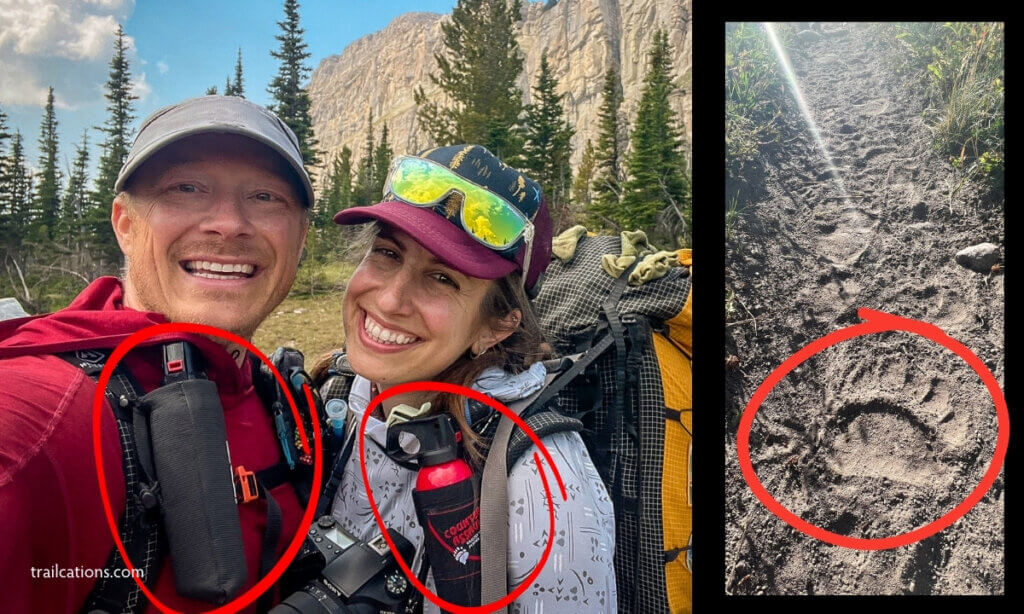
Region-Specific Items for Day Hiking
Some regions might recommend special hiking gear as they are home to dangerous animals like venomous snakes (pack knee-high gaiters) or grizzly bears (bring bear spray and have it easily accessible).
In dry, desert environments, there might not be enough rain to decompose toilet paper or human waste so you may have to pack your #2 out in a kitty litter filled “WAG bag.” Yuck!
Region-Specific Hiking Items Examples
- Problem bear country: Bear canister for food storage
- Grizzly bear country: Bear spray (have this easily accessible where you can have it hand in under 3 seconds)
- Desert or canyon hiking: Human waste bags or WAG bags
- Cactus country: Tweezers or pliers for removing cactus spines
- Tick country: Tweezers to remove attached ticks
- Tick country: Permethrin sprayed on gear before your hike
- Snake country: Tall boots and/or thick knee-high gaiters to protect from bites

“Luxury” Items for Day Hiking
In hiker lingo, “luxury items” are gear that isn’t necessary for your hike but may help you better enjoy your outdoor adventure. It could be something as small as a hiking journal to a heavy photography camera set up.
Just remember to not overpack! Ounces = Pounds; Pounds = Pain!
Luxury Items Examples for Day Hiking
- Ultralight chair or foam sit pad
- Ultralight hammock for relaxing
- Trekking poles (the more I hike, the more I love these!)
- DSLR camera, tripod, lenses
- Journal and pen
- Book, Tablet/e-Reader
- Extra clothing
- Sports equipment – football, softball, frisbee
- Alcohol
- Coffee
- Bluetooth speaker (*sigh* – blaring music in the backcountry is the bane of many hikers’ existence)
- Solar charger
- Picnic blanket
- Games – cards, dice, lightweight chess set
- Instrument – lightweight guitar, fiddle, harmonica
- Battery-powered fan
By bringing these essential (and maybe not-so-essential) items on your day hike, you can have a safer and more enjoyable experience on the trails.
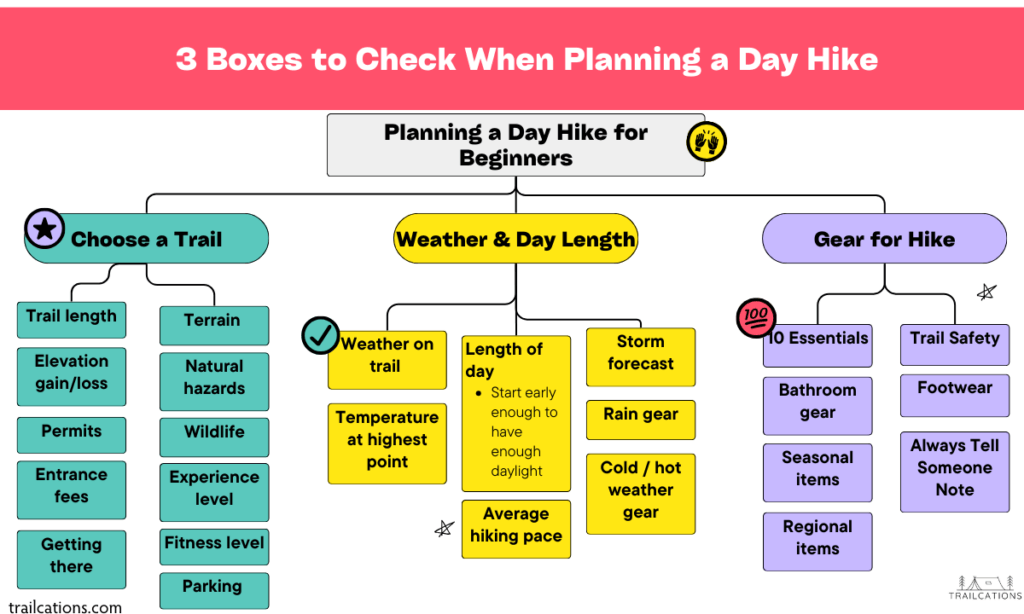
How Do I Plan a Day Hike? 3 Boxes to Check for Beginner Day Hikers
When planning a day hike, there’s a few boxes to check to ensure a safe and fun experience. This section will cover the main considerations when planning a day hike, including choosing a trail, weather considerations and time management.
1. Choosing a Trail When Planning a Day Hike
Choose a trail that matches your fitness level and hiking experience. Consider the trail’s difficulty, length and terrain, as well as the hiker’s experience level and physical fitness. Hikers should choose a trail that matches their skill level and allows them to comfortably complete the hike within the desired timeframe.
If you’re going with a group, keep in mind that you can only go as fast and as far as the slowest member.
Also check beforehand to see if you need permits, what the parking situation is like, any seasonal closures, weather conditions and if there is an entry fee.
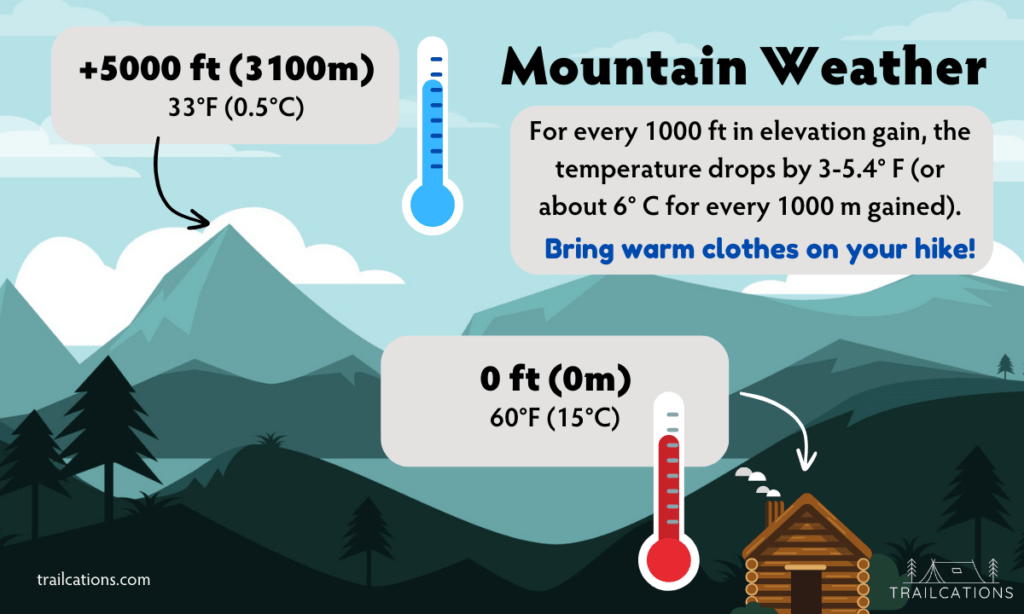
2. Weather & Daylight Considerations
Weather is a crucial factor to consider when planning a day hike. Hikers should always check the weather forecast before heading out and pack accordingly. It’s important to bring layers of clothing that can be easily added or removed, depending on the temperature. Hikers should also bring rain gear, even if there is no forecast for rain, as weather conditions can change quickly.
Pro Tip: When checking the weather for a trail, weather stations usually default to the nearest town which are often at lower elevations than the surrounding mountains. For every 1000 ft gained in elevation, the temperature decreases by 3-5.4° F (or about 6° C for every 1000 m gained).
Time Management for Beginner Day Hikers
Time management is another important consideration when planning a day hike. Hikers should start early in the morning to ensure they have enough daylight to complete the hike. It’s important to factor in breaks for rest and snacks, as well as time to enjoy the scenery.
Hikers should also plan for unexpected delays, such as getting lost or encountering difficult terrain. The average hiker can travel about 2 mph (3.2 kph) but trail difficulty, weather conditions and rest breaks can all factor into how fast or slow you hike.
3. Packing the Right Gear and Equipment for Beginner Day Hikers
When it comes to day hiking, having the right gear and equipment can make all the difference. In this section, we’ll cover the essential items you’ll need for a successful day hike.
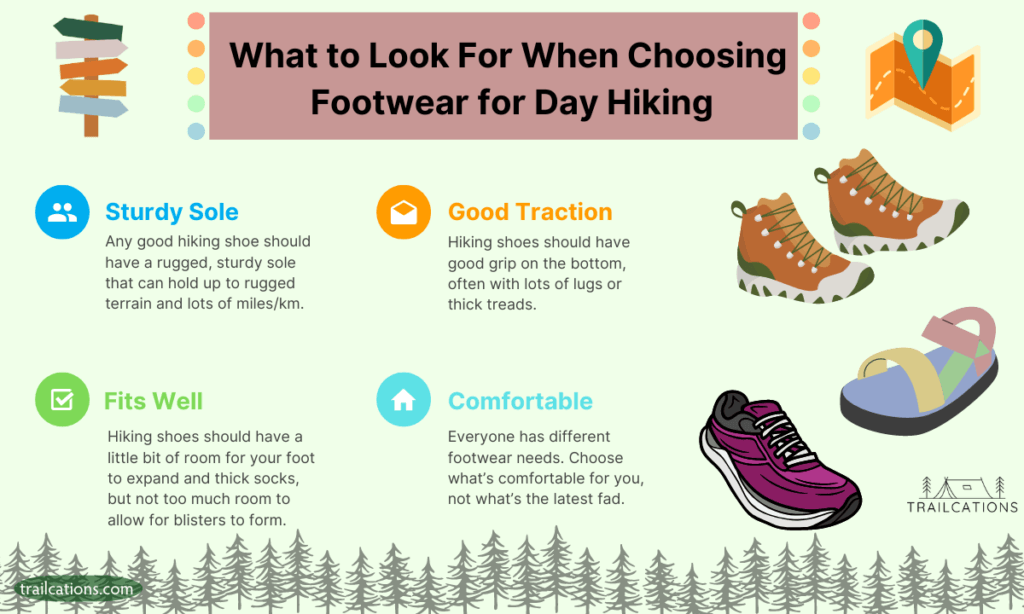
Footwear Recommendations for Beginner Day Hikers
Happy feet make for a happy hiker! One of the most important pieces of gear for any hiker is their footwear. A good pair of hiking boots, shoes or sandals can provide the support and protection needed to tackle any trail.
Look for shoes with a sturdy sole and good traction to help prevent slips and falls. It’s also important to choose shoes that fit well and are comfortable for long periods of walking. Unless you have very narrow feet, opt for a shoe with a wide toe box to allow for thick socks and foot expansion, especially if you’re doing longer hikes.
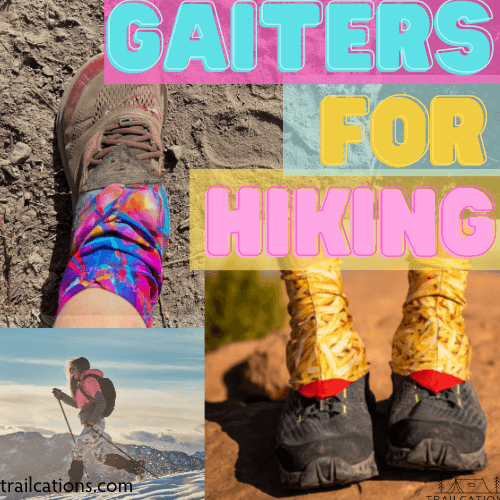
Pro Tip: One of the best decisions I ever made in terms of hiking gear was buying gaiters for my hiking shoes. Gaiters are thin pieces of fabric that wrap around your ankle and attach to your shoe, keeping out sand, dirt, rocks and debris from getting inside your shoe. #gamechanger
Pro Tip: New boots often need a “breaking in” period to allow the stiff materials to flex and form to your feet. Don’t wait until your hike to break in your boots or you’ll likely have sore feet!
Backpack Essentials
A small backpack allows you to carry all the gear and supplies you’ll need for your hike. When choosing a backpack, look for one that is the right size for your needs. A 20-30 liter backpack is ideal for day hikes, especially for beginners who might not have compact, lightweight gear.
Inside your backpack, you’ll want to pack the following essentials:
- Water: Staying hydrated is key when hiking. Bring at least 2 liters of water per person.
- Snacks: Pack high-energy snacks like trail mix, energy bars, and fruit to keep you fueled throughout your hike.
- First Aid Kit: Accidents can happen on the trail, so it’s important to be prepared with a basic first aid kit.
- Sun Protection: Protect yourself from the sun with sunscreen, sunglasses, and a hat.
- Extra Clothing: Even on a warm day, temperatures can drop quickly in the mountains. Pack extra layers like a fleece jacket or rain shell.
Navigation Tools
Navigating the trail is an important part of any hike. Even if you’re hiking on a well-marked trail, it’s always a good idea to bring a few navigation tools with you. Here are a few essentials to consider:
- Map and Compass: A map and compass can help you navigate the trail and find your way if you get lost.
- GPS: A handheld GPS device can be a helpful tool for tracking your progress and finding your way back to the trailhead.
- Phone: Bring your phone with you in case of an emergency. Just be sure to keep it in airplane mode to conserve battery life and a battery pack for extra juice.
By packing these essential items, you’ll be well-prepared for your day hike and ready to tackle any trail with confidence.
Safety and Preparedness
When it comes to day hiking, safety and preparedness are of utmost importance. Hikers should always be aware of their surroundings and take necessary precautions to ensure a safe and enjoyable hike.
- Emergency Shelter: A lightweight space blanket, tarp, tent or bivy will provide extra warmth in case of an emergency.
- Gear Repair: Duct tape wrapped around hiking poles, a small knife or multitool, a tiny sewing kit and super glue can fix 99% of gear repairs in the field.
- Signaling tools: A whistle and signaling mirror can alert rescue teams to your location. Personal Locator Beacons (PLBs) and satellite phones can contact authorities in an emergency, even without cell service.
- Fire starter: Always have 2 methods to start a fire – a lighter, waterproof matches and fire striker are great options.
Trail Safety
Before hitting the trails, hikers should research the trail they plan to hike and take note of the distance, elevation gain, and potential hazards such as avalanches, rockfall, river crossings and flash floods.
It is also important to check weather conditions and pack appropriate clothing, including layers and moisture-wicking materials. Navigation tools such as a map and compass should be carried at all times. Hikers should also inform someone of their hiking plans and expected return time.
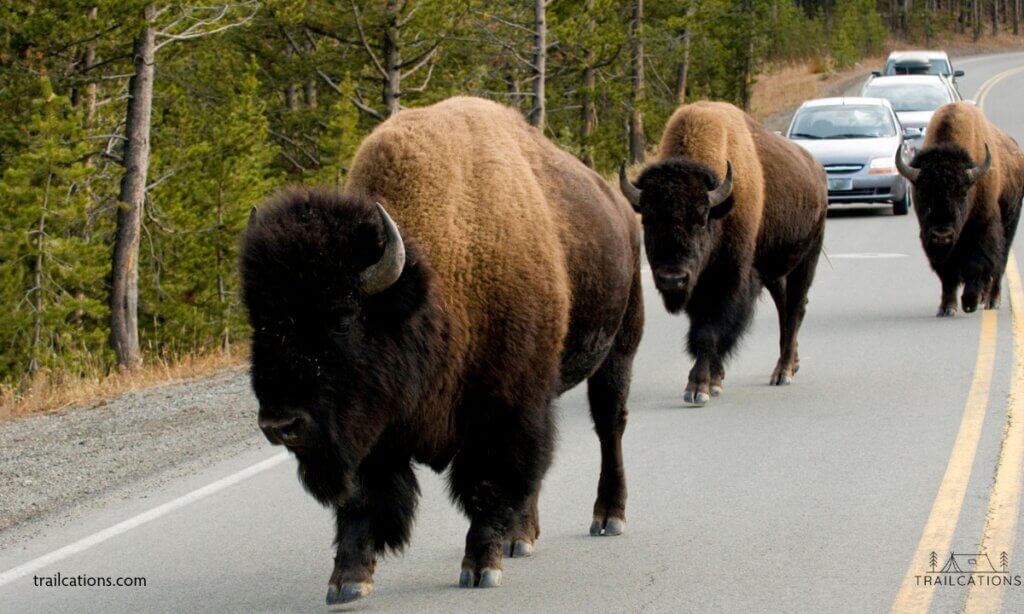
Wildlife Encounters
Encounters with wildlife are possible on any hiking trail. Hikers should always maintain a safe distance from wildlife and never approach or feed them. It is also important to properly store food and trash to avoid attracting animals. Hikers should be aware of the signs of wildlife activity, such as tracks and droppings, and take necessary precautions in areas known to have bears or other large animals.
First Aid
In case of injury or emergency, hikers should always carry a first aid kit and know how to use it. The kit should include items such as bandages, gauze, tweezers, and antiseptic wipes. Hikers should also know basic first aid skills such as how to treat blisters, cuts, and sprains. It is also important to carry enough water and food to sustain oneself in case of an emergency.
By following these safety and preparedness guidelines, hikers can ensure a safe and enjoyable day on the trails.

Trail Etiquette for Beginner Day Hikers (and a Friendly Reminder for Experienced Hikers)
When hiking, it is essential to follow proper trail etiquette to ensure a safe and enjoyable experience for everyone. Here are some important tips to keep in mind:
Leave No Trace – Leave Only Footprints, Take Only Pictures
Hikers should always follow the Leave No Trace principles. This means packing out all trash, including food scraps and toilet paper. Hikers should also avoid widening the trail by going around puddles and mud. Cutting corners off switchbacks is also a bad idea, as it can cause erosion and damage to the trail. Leave only footprints, take only pictures.
- Pack out all trash including toilet paper, food scraps, micro-trash (wrappers, pieces of plastic, cigarette butts). Never burn trash as residual smells attract animals.
- Deposit solid human waste in a hole dug 6-8 inches (15-20 cm) deep at least 200 ft (61 m) from water, campsites and trails. Cover the hole when you’re done. As a park ranger once told us, “You should feel comfortable sitting on the cathole after you’ve finished.” Dig deep my friends.
- When washing your hands or dishes with soap, carry water 200 ft (61 m) from any water sources. Biodegrable soap still contaminates water sources and surfactants can kill fish and aquatic life. If you wouldn’t drink it, don’t let it run off into the water source.
- Don’t cut off switchbacks or widen trails.
- Don’t dig trenches, carve into trees or rocks, build structures or furniture.
- Leave plants, rocks and other natural objects behind – they are often protected for a reason.
- Preserve history – look at cultural or historic artifacts and structures but do not touch or take them. Many objects are considered sacred and their locations invaluable to their people’s descendants, as well as archaeolgists.

Respect Wildlife
When hiking, it is extremely important to respect wildlife and their natural habitats. Hikers should never feed wildlife, as it can cause them to become dependent on humans for food which can lead to aggressive behavior, spreading diseases to humans and potentially have to be killed. Hikers should also avoid approaching wildlife too closely, as it can cause stress and disrupt their natural behavior. Don’t find yourself on some viral social media platform under the #touron (tourist + moron).
- Observe wildlife from a distance and never follow or approach an animal. The wilderness is not a zoo. Wild animals may appear cute and cuddly right before they stomp, kick, gore or eat you.
- Never feed wild animals as you can catch a disease from them or can be attacked or killed.
- Control your pets at all times or leave them at home, especially in areas with bears, mountain lions, alligators and other large predators. Pets often attract large predators towards you.
- If there are special food storage requirements, follow them. Keep an eye on your food and pet’s food at all times if it isn’t stored in an animal proof container or hung from a tree.
Why You Don’t Feed Wildlife While Hiking
Pro Tip: A fed animal is a dead animal. This is especially true with large wildlife like bears. Unfortunately this year I met a park ranger at Glacier National Park who a few days before had to shoot a young female grizzly bear because a camper fed it.
After a camper fed the 400 lb grizzly, the bear became aggressive, attacking a family picnicking in a populated area to steal their food. It ran amok in the nearby campground where they had to shut down camping to anyone in a soft sided tent. Rangers stepped in and euthanized the bear before it could hurt or kill a human. The park was actually trying to pursue criminal charges against the camper who had been repeatedly told to put away food and had announced to the campground host he was baiting a bear with food to take its picture. Now a young bear who never had the chance to have cubs or grow up to adulthood is dead, just because a tourist “wanted to see a bear close up.”
Pro Tip: Did you know that cute little chipmunk you fed trail mix to actually carries the bubonic plague? And that fluffy marmot carries Rocky Mountain Spotted Fever which if not treated in the first 5 days is often deadly. Hope you didn’t get bit, scratched or had fleas/ticks jump onto you while feeding those wild critters!
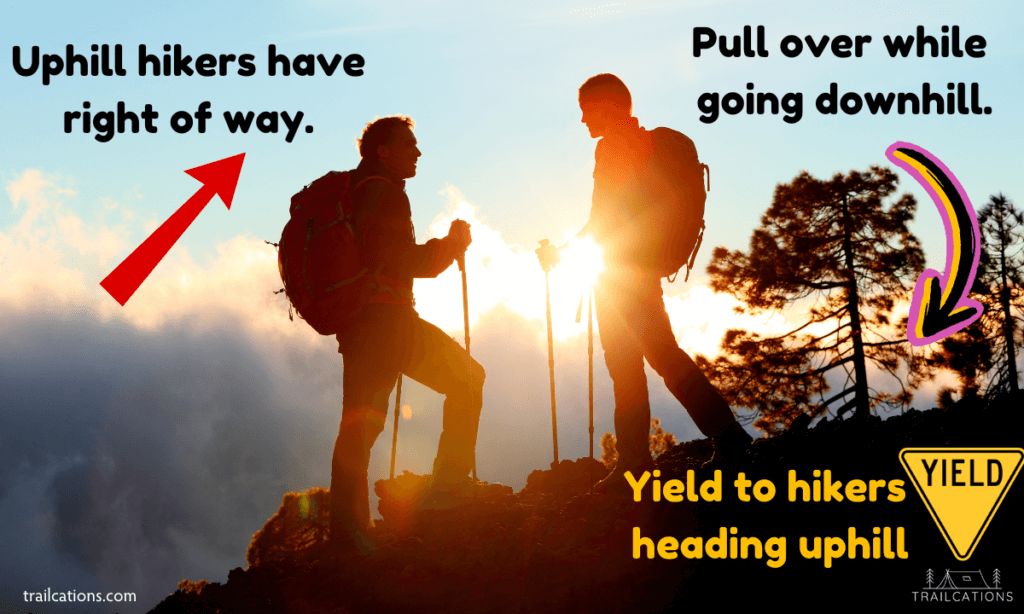
Yielding on the Trail
When encountering other hikers on the trail, it is important to yield the right of way to those going uphill. Hikers descending should step to the side to make room for those hiking up to pass. On trails that allow other types of users, hikers should always yield to horses, mules, llamas and any other pack animals. Bikers must yield to hikers and horses.
- Hikers going up the trail have the right of way. Pull over to let them by while you’re heading downhill.
- Yield to pack animals and watch out for bikers on the trail. Oftentimes mountain bikers are going too fast to see you until it’s the last minute!
Be Considerate of Others: Leave Your Bluetooth Speaker at Home
Let nature’s wild sounds prevail – don’t scream unless you’re in trouble or blast your speaker because you didn’t want to put on headphones. Remember that people come out to the wilderness to destress from their busy lives and the last thing they want to hear is music blasting on 11 while they’re trying to enjoy the serene sounds of nature. It’s actually illegal to blast your speakers in many National Parks and Wilderness Areas. Save the speaker for listening to music at your hotel later that evening.
- Save the screaming and yelling for when someone is actually in trouble.
- Don’t blast your speakers in the wilderness, y’all! It labels you as inexperienced and is actually illegal in many wilderness and national park areas.
Pro Tip: Use the 1 headphone in, 1 headphone out approach while hiking and listening to music, podcasts, etc. so you can hear what’s going on around you. If there’s a bear, rattlesnake, thunderstorm or other natural hazard, you want to be aware of your surroundings. I definitely do NOT recommend listening to headphones in grizzly bear country.
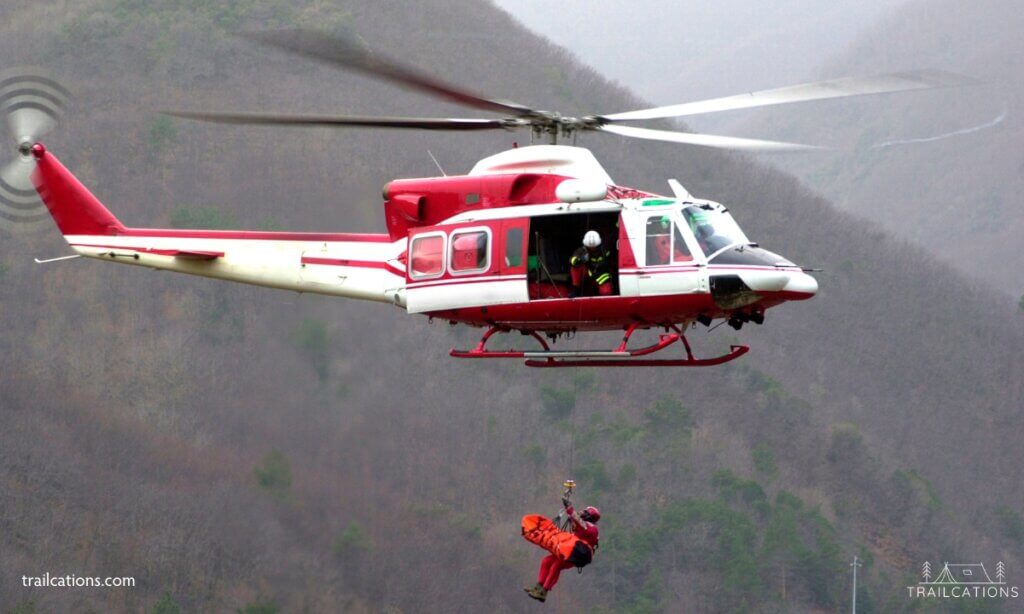
Plan Ahead and Be Prepared
Finally, hikers should always be prepared for the trail. This means carrying plenty of water, food, and appropriate clothing for the weather. Hikers should also carry a map and compass, and know how to use them. It is also a very good idea to let someone know where you are going and when you expect to return.
Reckless Planning and Behavior Endangers Others (and You Can Be Criminally Charged)
Hikers who require rescue due to reckless behavior or being unprepared put the lives of entire Search-and-Rescue, emergency service and volunteer teams in danger. Recently, hikers in the US are being charged more and more with reckless conduct, fines and possible jail time for rescues required due to reckless behavior.
- Carry enough water and food for your hike. When in doubt, carry a little bit more than you think you’ll need.
- Wear layers of quick-drying clothing that is appropriate for the weather.
- Always let someone know where you’re going and when you’ll be returning.
Pro Tip: Carry a Personal Locator Beacon (PLB) or satellite phone in case of emergencies. They’re extremely lightweight and invaluable for contacting authorities when cell service is nonexistent.
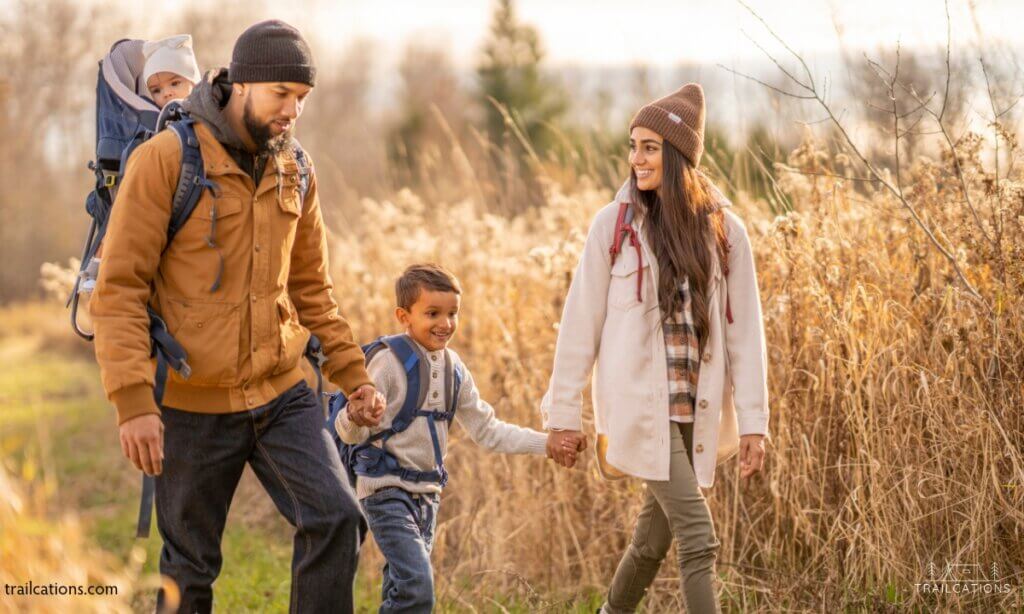
Benefits of Day Hiking for Health and Wellness
Day hiking is a great way to get exercise and fresh air while enjoying the beauty of nature. Here are some of the benefits of day hiking for health and wellness:
Physical Benefits of Day Hiking
- Cardiovascular Health: Hiking is a great way to improve your heart health. It is a low-impact exercise that gets the heart pumping and blood flowing, which helps to reduce the risk of heart disease.
- Weight Loss: Hiking is a great way to burn calories and lose weight. Depending on the intensity and duration of the hike, the average person can burn anywhere from 300 to 600 calories per hour of hiking.
- Stronger Muscles and Bones: Hiking is a weight-bearing exercise that helps to strengthen the muscles and bones. It can help to prevent osteoporosis and improve overall muscle tone. It’s like leg day, but with views!
- Improved Balance and Coordination: Hiking on uneven terrain can help to improve balance and coordination. This can help to reduce the risk of falls and improve overall mobility.
Pro Tip: Using hiking poles or trekking poles is a great way to not only tone your arm, back and shoulder muscles but also help with balance on uneven or steep terrain. Who would’ve thought hiking could be a full body workout?

Mental Benefits of Day Hiking
- Reduced Stress and Anxiety: Spending time in nature can help to reduce stress and anxiety. Hiking can provide a sense of peace and tranquility that is hard to find in the hustle and bustle of everyday life.
- Improved Mood: Hiking can help to improve mood and reduce symptoms of depression. It releases endorphins, which are natural mood-boosters and provides a sense of accomplishment and satisfaction. Plus, who stay mad when they’re at the top of a beautiful mountain overlook?
- Increased Creativity: Hiking can help to increase creativity and problem-solving skills. It provides a break from the daily routine and allows the mind to wander and explore new ideas. I’ve gathers some of my best ideas for writing, drawing and business while hiking!
Overall, day hiking is a great way to improve both physical and mental health. It provides a fun and rewarding way to get exercise and enjoy the beauty of nature.
Fitness and Training for Day Hiking for Beginners
Physical Conditioning for Day Hiking
Day hiking requires a certain level of physical fitness. Hikers should be able to walk for several hours at a time and climb steep hills or mountains. To prepare for a day hike, hikers should engage in regular aerobic physical activity such as walking, jogging, cycling, using the elliptical or stair master. But cardio isn’t everything! Strength training is especially important, especially exercises that focus on the legs and core.
Hikers should start their training at least a few weeks before the hike. A good mix of workout types for beginner hikers each week involves the following:
- 2 nonconsecutive days of strength training, including exercises such as squats, lunges and planks.
- 2 nonconsecutive rest days; take more any time you feel your body needs it.
- 3 nonconsecutive cardio sessions weekly until the final two weeks before a major hike.

My Favorite YouTube Channels for Strengthening and Conditioning for Hiking
Some of my favorite workout video series for physical training to get in shape for hiking are as follows:
Strength Workouts for Hiking
- Caroline Girvan – Dozens of high quality, multi week strength training series with or without weights. You don’t even have to think – her no frills, multi week or multi month playlists are curated to actually building muscle 3-5 days a week.
- Heather Robertson – Daily workouts for a whole calendar year, dozens of multi week strength and cardio series.
- Pamela Reif – Amazing beginner workouts, results-driven ab workouts, cardio dance and strength workouts for all levels. I never knew some of my muscles existed until Pam came into my life.
Cycling Crosstraining Workouts for Hiking
- Global Cycling Network – Cycling workouts can be fun – whaaat? This UK-based group has made my cross-training cycling days something to look forward to. They have lots of cycling-geared videos but their workouts will leave you sweaty and your calves, butt, abs and hamstrings will be looking goodt with a t.
Yoga Workouts For Hiking
- Move With Nicole – One of my favorite yoga channels where I actually feel like I get a good workout and my muscles are loosened. From post-workout stretches to sweaty pilates workouts to intense flow workouts, I try to do these at least once a week.
My Hiking Workout Training
Personally I try to do strengthening 3-4 times a week, yoga 1-2 times a week. I also try to do 30 to 60 minutes cardio 5-6 times a week through runs, hikes, walks, cycling or elliptical. However, if I don’t get a lot of working out in, my brain goes a little wonky. Keep in mind what works for me might be too much or too little for you. Listen to your body and try to get cardio in at 3-4 days a week and strength training 2-3 times a week. Let us know what your favorite hiking workouts are!
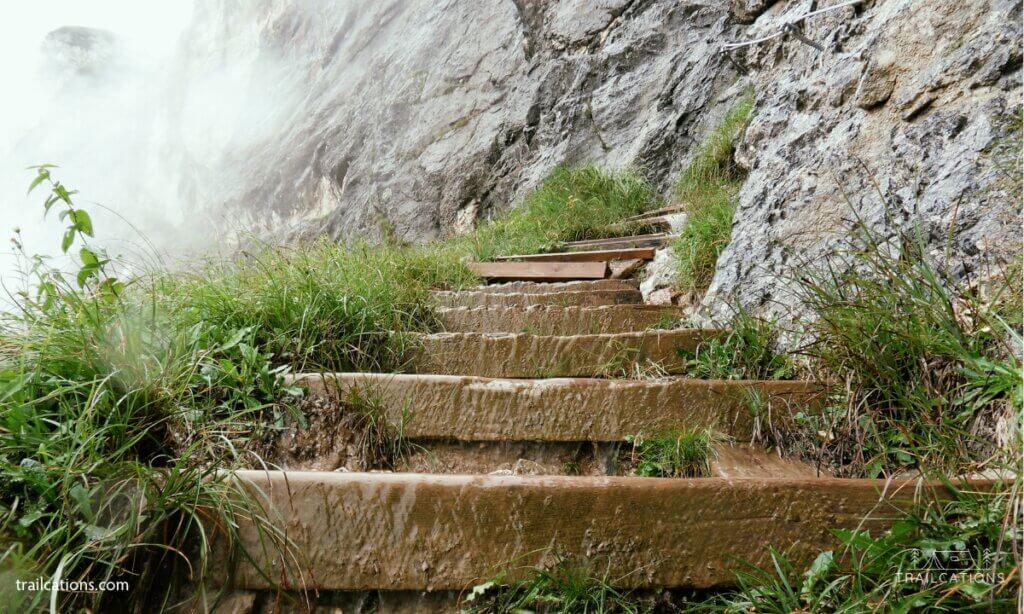
Hiking Techniques for Beginner Day Hikers
In addition to physical conditioning, hikers should also learn proper hiking techniques. This includes learning how to use hiking poles, how to navigate different types of terrain, how to know when to take a break and how to pace oneself during a hike. Also, if no one’s told you yet: it’s OKAY to go slow on tricky terrain like rocks, steep downhills or loose scree.
Nutrition and Hydration for Beginner Day Hiking
Day hiking can be a fun and rewarding experience, but it can also be physically demanding. To ensure a successful hike, it is important to pay attention to nutrition and hydration.
Snacks and Meals for Day Hiking
When planning meals and snacks for a day hike, it is important to consider the length and intensity of the hike. For shorter hikes, simple snacks such as trail mix, granola bars and fresh or dried fruit can provide the necessary energy to keep going. For longer hikes, more substantial meals may be necessary and salty snacks or electrolyte drink mixes are a must.
It is important to choose foods that are high in energy and easy to digest. Foods that are high in carbohydrates such as pasta, bread and rice can provide sustained energy throughout the day. Protein-rich foods such as nuts, cheese and jerky can help to build and repair muscles.
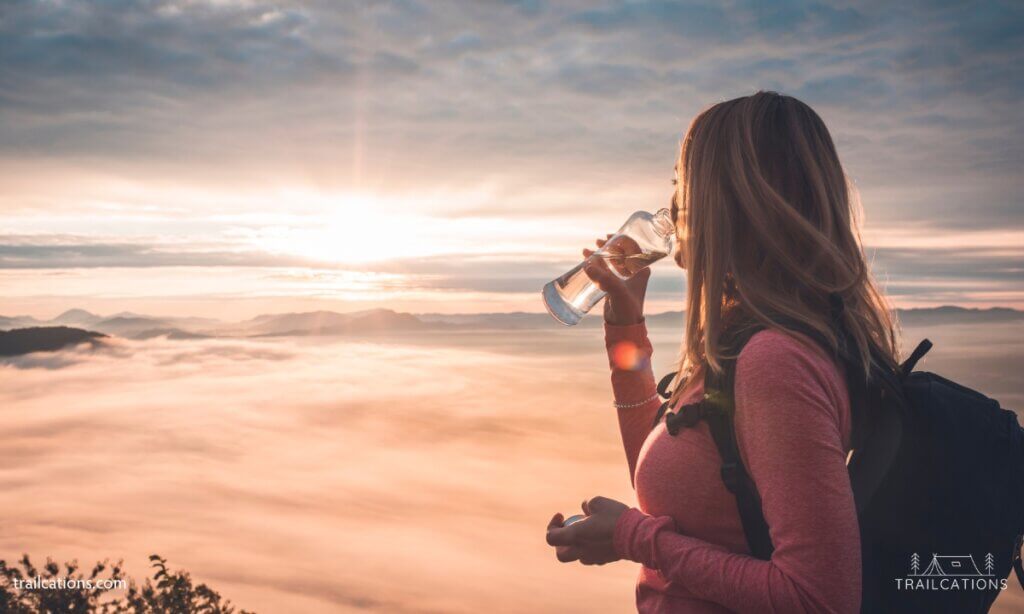
Staying Hydrated While Day Hiking
Staying hydrated is crucial during a day hike. Dehydration can lead to fatigue, headaches, dizziness and severe health problems. The US National Academies of Science, Engineering and Mathematics determined that the average person should drink between 2.7 – 3.7 liters of water per day.
Hot Weather = Drink More Water
However, you’ll definitely need to increase this amount of water during an active hike, especially one that lasts the entire day. REI recommends drinking about 1 liter of water for every 2 hours of hiking. Depending on the temperature, humidity, intensity of the hike and any medications or healthy conditions, you’ll need to drink more.
Electrolytes to Replace Salts Lost to Sweat
In addition to water, sports drinks can also be beneficial during a hike. These drinks contain electrolytes, which can help to replace the minerals lost through sweat. It is important to avoid sugary drinks and alcohol, which can actually lead to dehydration.
Drink Before You’re Thirsty
To ensure that water is always available, it is recommended to carry a hydration system or water bottles. It is also a good idea to drink water regularly throughout the hike, rather than waiting until feeling thirsty.
Environmental Impact
Day hiking is a fun and rewarding activity, but it’s important to be aware of the potential environmental impact it can have. By following Leave No Trace principles and practicing responsible trail use, hikers can help minimize their impact and preserve the natural beauty of the outdoors for future generations.
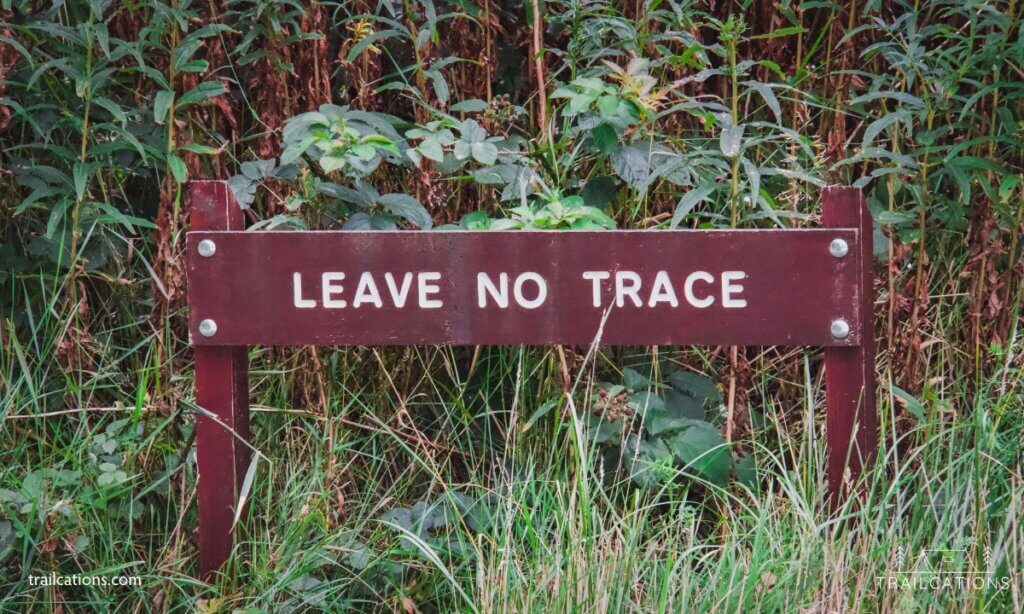
Leave No Trace
The Leave No Trace Center for Outdoor Ethics has developed seven principles to help hikers minimize their impact on the environment:
- Plan ahead and prepare
- Travel and camp on durable surfaces
- Dispose of waste properly
- Leave what you find
- Minimize campfire impact
- Respect wildlife
- Be considerate of other visitors
By following these principles, hikers can help protect the environment and ensure that future generations can enjoy the outdoors as well.
Responsible Trail Use
In addition to following Leave No Trace principles, hikers should also practice responsible trail use. This includes staying on designated trails, avoiding shortcuts that can cause erosion and not disturbing wildlife or plant life.
Hikers should also be mindful of their impact on other visitors. This includes yielding to other hikers on the trail, keeping noise levels down, and not blocking the trail.
By practicing responsible trail use and following Leave No Trace principles, hikers can help minimize their impact on the environment and ensure that future generations can enjoy the outdoors as well.
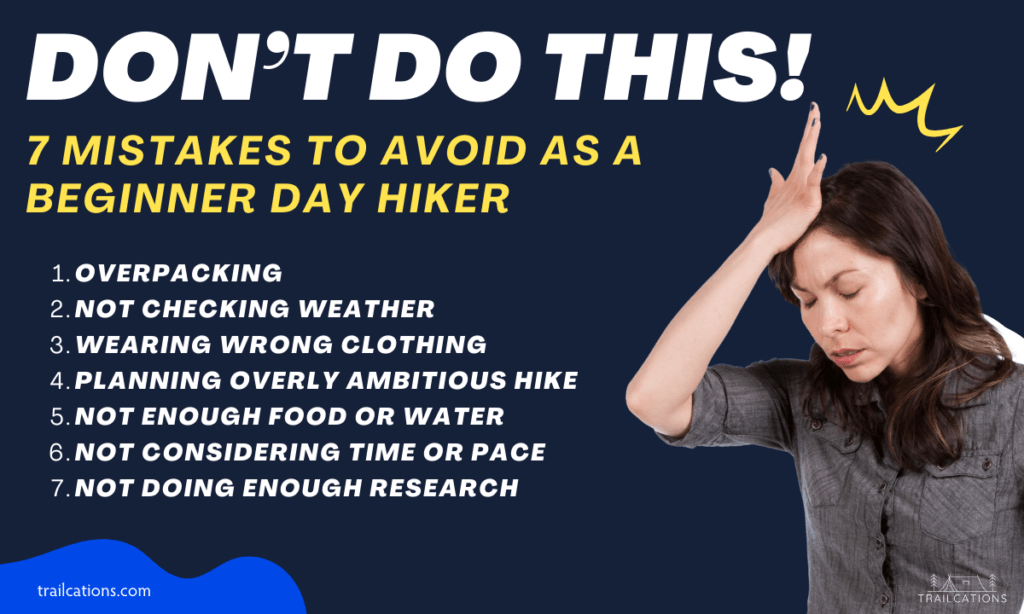
What Are Common Mistakes Beginners Make When Hiking?
You’re going to make a lot of mistakes when hiking, especially when you’re first starting out. We’ve all been there so don’t sweat it! Even after spending literally years of my life hiking, I still come back from every trip learning something new!
Some common mistakes beginners make when hiking include:
1. Overpacking:
Bringing too much gear, clothing or unnecessary items can weigh you down and make the hike more challenging. Ounces = pounds, pounds = pain!
2. Not Checking the Weather:
Failing to check the weather forecast can lead to being unprepared for changing conditions, potentially putting the hiker in danger. Rainstorms in the desert, snow in the mountains or heat waves on a hike can all quickly become dangerous if you’re unprepared.
3. Wearing the Wrong Clothing:
Inappropriate clothing choices can lead to discomfort, overheating, exposure or even hypothermia. It’s important to dress in layers and consider the weather and terrain. Also never wear cotton and instead opt for a fast-drying fabric like wool, polyester, nylon, bamboo, alpaca or other material.
4. Planning an Overly Ambitious Hike:
Underestimating the difficulty of a trail or overestimating one’s abilities can lead to exhaustion, injury, or getting lost. It’s important to start with hikes that match your fitness level and gradually progress. One of my first overly ambitious hikes we were caught on the mountain after dark and got chased by a black bear (or maybe a Sasquatch, who knows) that was protecting its kill. At least one of us peed our pants and all of us screamed until we made it back to the car an hour later.
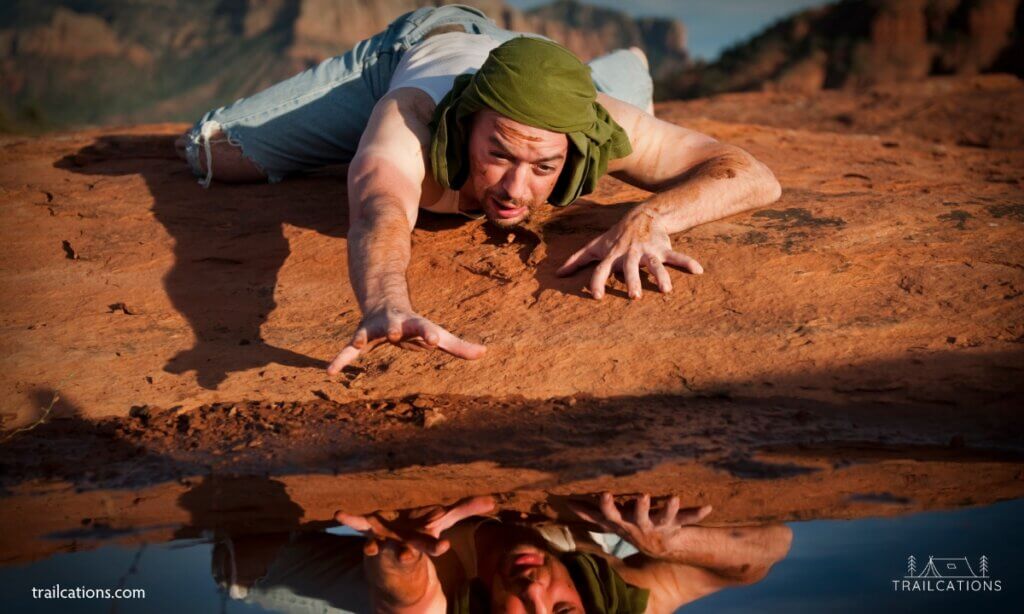
5. Not Bringing Enough Food and Water:
Failing to pack sufficient food and water can lead to dehydration, fatigue, and other health issues. It’s essential to plan and pack an adequate supply of nutrition and hydration. Don’t become a Search-and-Rescue statistic – familiarize yourself with the signs of dehydration, heat exhaustion and heat stroke.
6. Not Considering Time and Pace:
Beginners may overestimate their hiking speed and endurance, leading to fatigue and potential safety issues. It’s important to plan a realistic pace and consider rest breaks. Always plan your hike length with the slowest group member in mind and remember to take rest breaks. If the US Army mandates rest breaks for soldiers, it’s okay for you to take one too (especially in hot weather).
7. Not Doing Enough Research and Planning:
Inadequate understanding of the trail, lack of planning, bad logistics and not having essential navigation tools can lead to getting lost or encountering unexpected challenges. Thorough research and planning are essential for a safe and successful hike.
In summary, common mistakes made by beginner hikers include overpacking, lack of preparation, underestimating trail difficulty, and not considering essential factors such as weather, clothing, and pacing. Thorough preparation, research, and a realistic assessment of one’s abilities are key to avoiding these pitfalls.
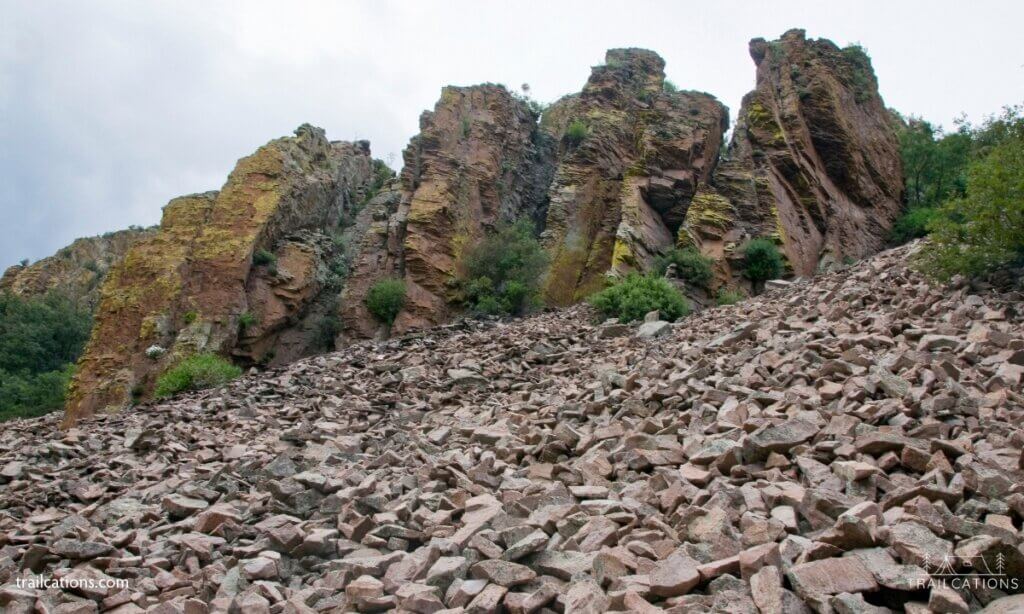
What Not to Do on Your First Day Hike: My Real Life Brush with Death
Mistake #1: Getting Lost
When I was first learning how to day hike, my friend and I had no idea what we were doing as we had both grown up in the city, far from the mountains. We got lost because we didn’t know how to read a map and accidentally hiked up a rock slide after a big rainstorm, which I now know is super dangerous.
Mistakes # 2 & 3: Underestimating Trail Difficulty and Bad Gear
After scrambling around loose boulders for a long time, getting cut up, bruised and almost breaking our ankles, we realized maybe we had underestimated how difficult the trail was. We were running low on water and daylight so we decided to turn around. Since we were broke college students, we didn’t have extra money for expensive hiking gear and our worn out shoes caused us to slide around on the slick rocks.
Mistake #4: Environmental and Weather Challenges
As we climbed painfully slowly down the steep, slippery mountainside on all fours, we heard a loud rumbling from above. A huge boulder the size of a microwave had dislodged from the cliffs and was bouncing down the mountain right towards us like a horrible real-life Indiana Jones movie. I yelled at my friend to move as I jumped sideways to get out of the way of the rock fall.
I kid you not – five seconds later, the massive boulder crashed right where my friend had been standing. The ground shook as it barreled down the mountain, smashing rocks into pulverized powder and breaking entire tree trunks like they were toothpicks.
Mistake #5: Safety and Emergency Preparedness
Luckily, my friend had just barely jumped out of the way in time after hearing me scream. Somehow both of us managed to walk away with only minor scrapes and bruises instead of skull-shattering injuries (or worse). I realized then that I was going to need to learn how to day hike safely or my friends and I were going to become a Search-and-Rescue statistic.
Frequently Asked Questions
What should I pack for a basic day hike?
When planning a day hike, it’s important to pack the right essentials. At minimum, you should bring the following items:
- Water (at least 1 liter for every 2 hours hiked) & water purification method
- Snacks, lunch and salty snacks or electrolytes
- Navigation tools (map, compass, GPS)
- Sun protection (hat, sunglasses, sunscreen)
- Insulation (extra clothing layers, rain gear)
- First aid kit
- Multi-tool or knife
- Headlamp or flashlight (with extra batteries)
- Emergency shelter (space blanket or bivy)
Can you list the top benefits of going on a hike?
Hiking has many benefits, both physical and mental. Some of the top benefits of hiking include:
- Improved cardiovascular health
- Increased strength and endurance
- Reduced stress and anxiety
- Improved mood and mental well-being
- Better sleep quality
- Increased connection with nature
How can I start hiking if I’m not currently active?
If you’re not currently active, it’s important to start slowly and build up your endurance to avoid injury (and have fun!). Some tips for getting started with hiking include:
- Starting with short, easy hikes
- Gradually increasing the length and difficulty of your hikes
- Wearing comfortable, supportive footwear
- Bringing plenty of water and snacks
- Hiking with a friend or group for safety and motivation
What type of footwear is best for a beginner hiker?
When it comes to footwear for hiking, it’s important to choose shoes that are comfortable, supportive and appropriate for the terrain. Some good options for beginner hikers include:
- Hiking boots (for difficult terrain, cold weather or if you need ankle support)
- Trail running shoes (for fast drying, ultralight footwear)
- Hiking sandals (for those going for a minimalist footwear – just don’t stub your toe!)
- Shoe gaiters for keeping out dirt, rocks and sticks
- Comfortable, fast-drying socks
How can I enjoy hiking without spending a lot of money?
- Finding free or low-cost hiking trails in your area
- Borrowing or renting gear instead of buying it
- Packing your own food and drinks instead of eating out
- Carpooling or taking public transportation to the trailhead
- Using free navigation apps like AllTrails, Garmin Explore, Komoot, Hiking Project, Gaia GPS, CalTopo or Avenza Maps.
What’s a reasonable distance for a beginner to hike in one day? How long is a day hike?
The distance a beginner can hike in one day depends on a variety of factors, including fitness level, terrain, pack weight and elevation gain. A good rule of thumb is to start with hikes that are 1-3 miles (1.6-5 km) long and gradually work up to longer distances as your fitness improves.
Can hiking replace leg day?
Does hiking count as leg day? Hiking can provide many benefits for leg muscles, such as building endurance and strength. Unfortunately, while hiking is excellent for strengthening and stamina, it is not a complete replacement for a dedicated leg workout.
Leg day exercises, such as squats, lunges and deadlifts, target specific muscles in the lower body and are essential for building muscle mass and strength. While hiking can contribute to leg muscle development, especially when tackling challenging terrain, it may not lead to the same level of muscle growth as a focused leg day at the gym.
If your goal is to build significant muscle mass and strength in your legs, a dedicated leg day workout should not be entirely replaced by hiking. However, hiking can be a great addition to an overall fitness routine, providing a cardiovascular workout and helping to improve leg muscle endurance.
One of my favorite hiking jokes is: “What do you call hiking up a mountain on a cloudy day with no views? Leg day!”